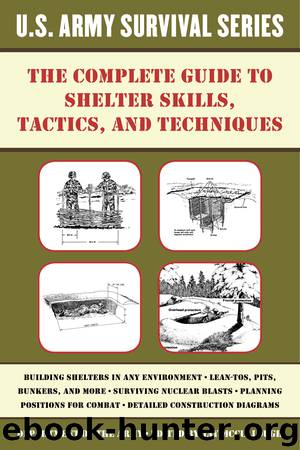The Complete U.S. Army Survival Guide to Shelter Skills, Tactics, and Techniques by Jay McCullough

Author:Jay McCullough
Language: eng
Format: epub
Publisher: Skyhorse Publishing
Published: 2016-01-25T16:00:00+00:00
Figure 1-7: Position with overhead cover protection against fragments from a 120-mm mortar
Delay Fuze Burst
Delay fuze shells are designed to detonate after penetration. Protection provided by overhead cover is dependent on the amount of cover remaining between the structure and the shell at the time of detonation. To defeat penetration of the shell, and thus cause it to detonate with a sufficient cover between it and the structure, materials are added on top of the overhead cover.
If this type of cover is used along with contact. burst protection, the additional materials (such as rock or concrete) are added in with the soil unit weight when designing the contact burst cover structure.
TRIGGERING SCREENS
Triggering screens are separately built or added on to existing structures used to activate the fuze of an incoming shell at a “standoff’ distance from the structure. The screen initiates detonation at a distance where only fragments reach the structure. A variety of materials are usually used to detonate both super-quick fuzed shells and delay fuze shells up to and including 130 mm. Super-quick shell detonation requires only enough material to activate the fuze. Delay shells require more material to both limit penetration and activate the fuze. Typical standoff framing is shown below.
Download
This site does not store any files on its server. We only index and link to content provided by other sites. Please contact the content providers to delete copyright contents if any and email us, we'll remove relevant links or contents immediately.
SAS Survival Handbook by John 'Lofty' Wiseman(2674)
Food and Water in an Emergency by Food & Water In An Emergency(2344)
Dangerous Personalities by Joe Navarro(2236)
Sea Survival Handbook by Keith Colwell(2199)
The Survival Medicine Handbook: A guide for when help is NOT on the way by Joseph Alton & Amy Alton(1798)
First Aid Handbook--Crucial Survival Skills, Emergency Procedures & Lifesaving Medical Information by Department of the Army(1795)
100 Skills You'll Need for the End of the World (as We Know It) by Ana Maria Spagna(1667)
The Survival Savvy Family by Julie Sczerbinski(1660)
Sheep No More by Jonathan T. Gilliam(1614)
TWA 800 by Jack Cashill(1596)
Prepper's Survival Medicine Handbook: A Lifesaving Collection of Emergency Procedures from U.S. Army Field Manuals by Scott Finazzo(1577)
Spy Secrets That Can Save Your Life: A Former CIA Officer Reveals Safety and Survival Techniques to Keep You and Your Family Protected by Jason Hanson(1563)
The Complete U.S. Army Survival Guide to Foraging Skills, Tactics, and Techniques by Jay McCullough(1489)
The Natural First Aid Handbook by Brigitte Mars(1434)
The Emergency Survival Manual by Joseph Pred(1434)
Be a Hero by John Geddes(1407)
Joey Green's Magic Health Remedies by Joey Green(1318)
The Zombie Survival Guide by Max Brooks(1297)
Poisoned by Jeff Benedict(1266)
